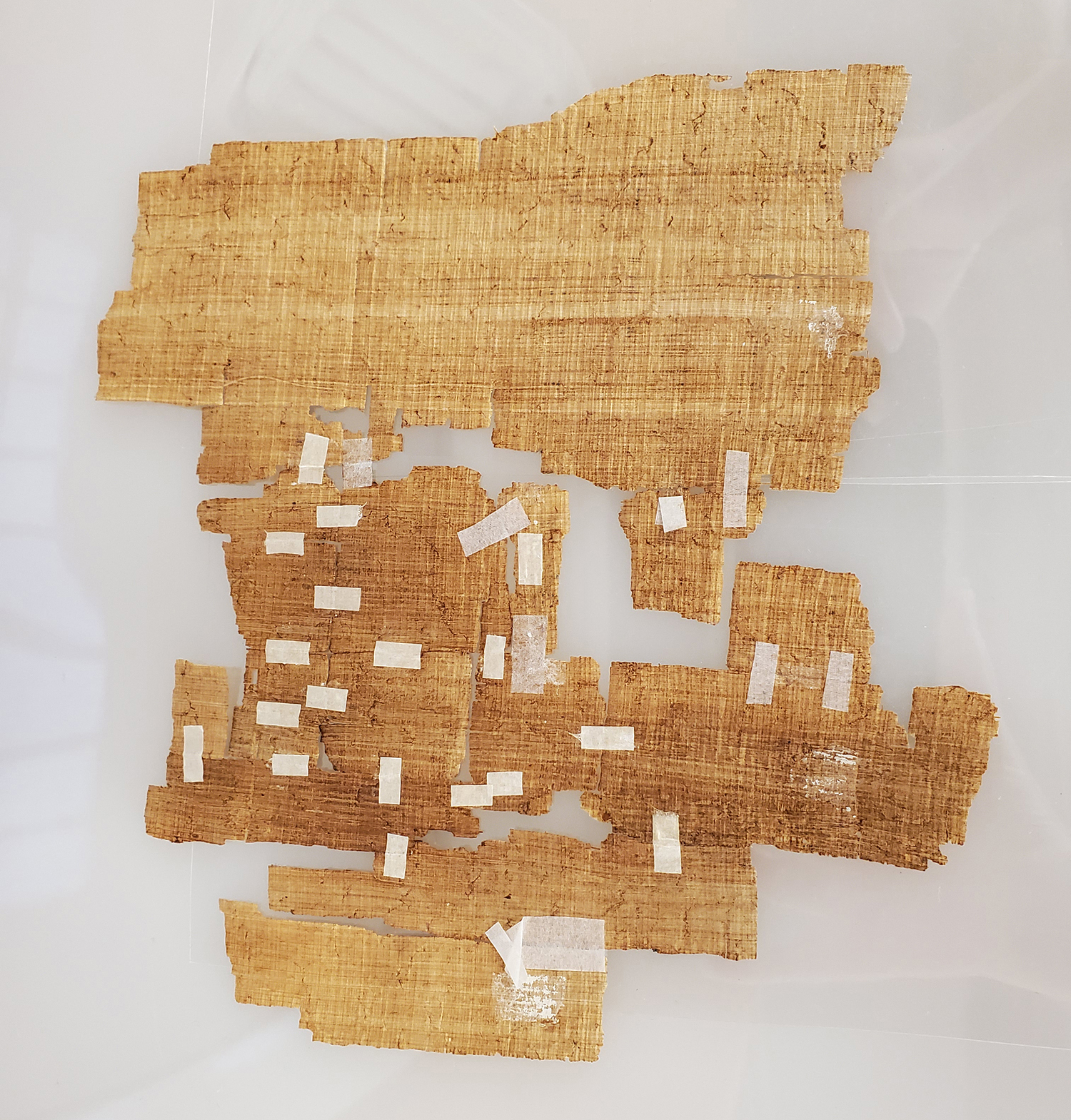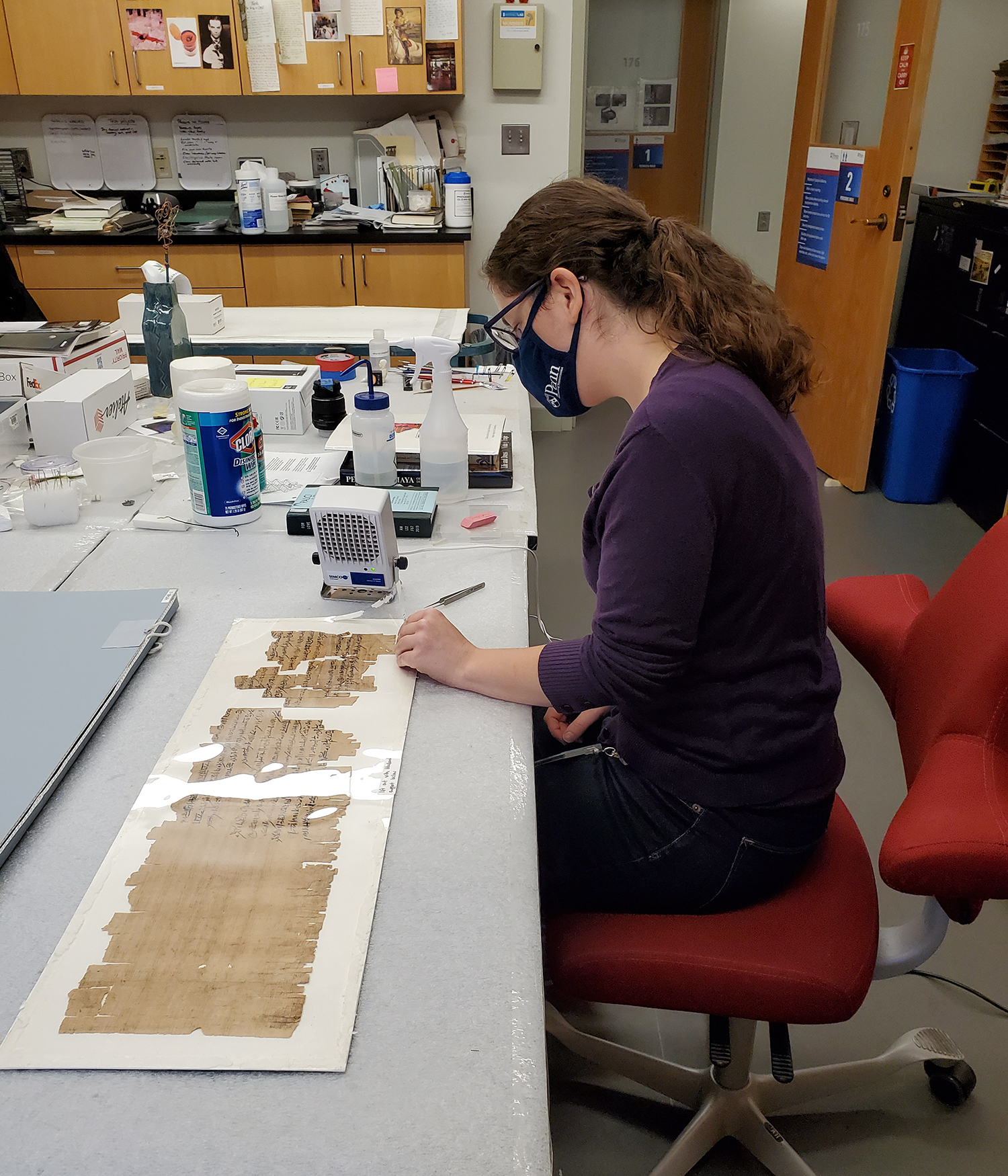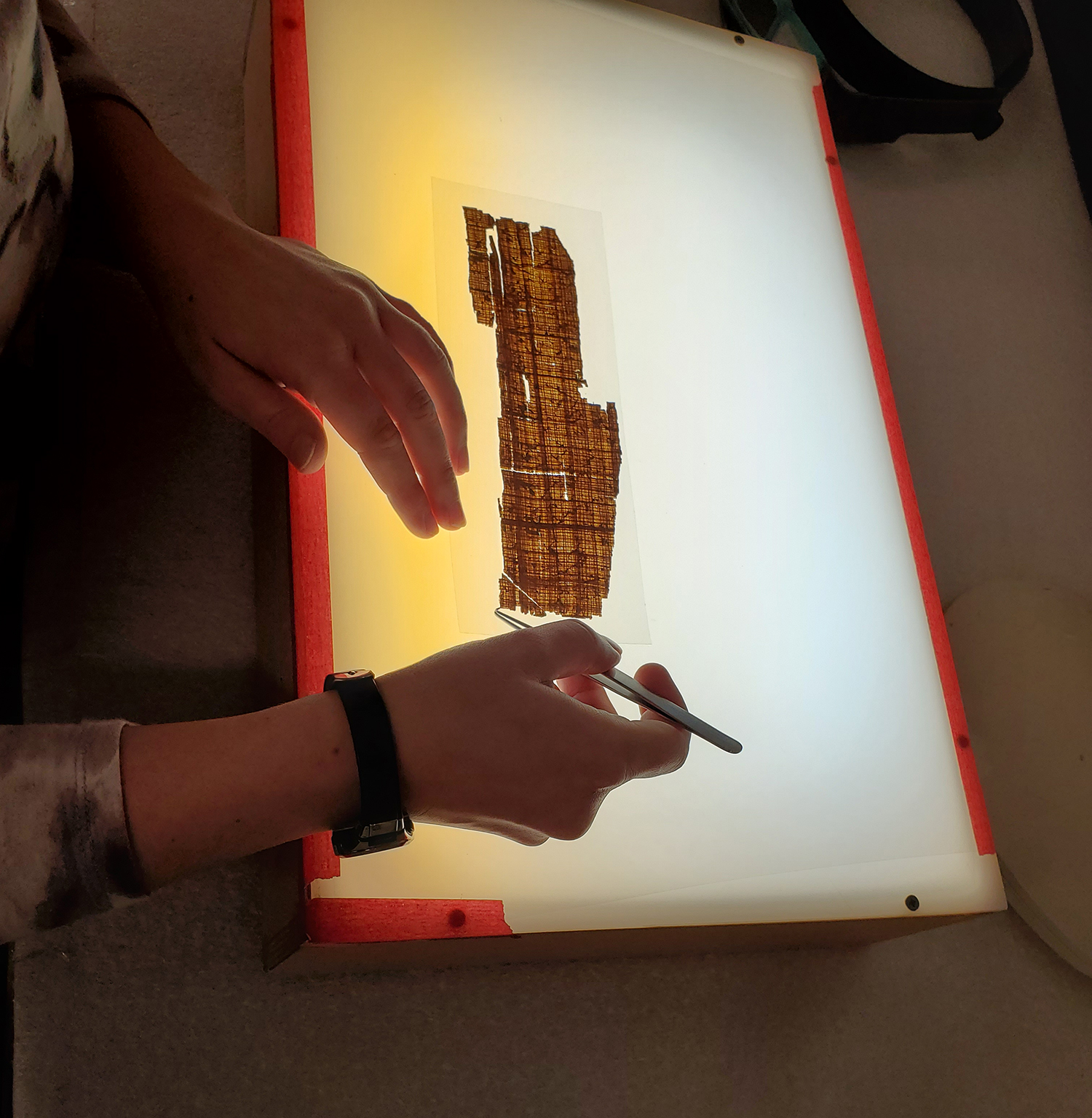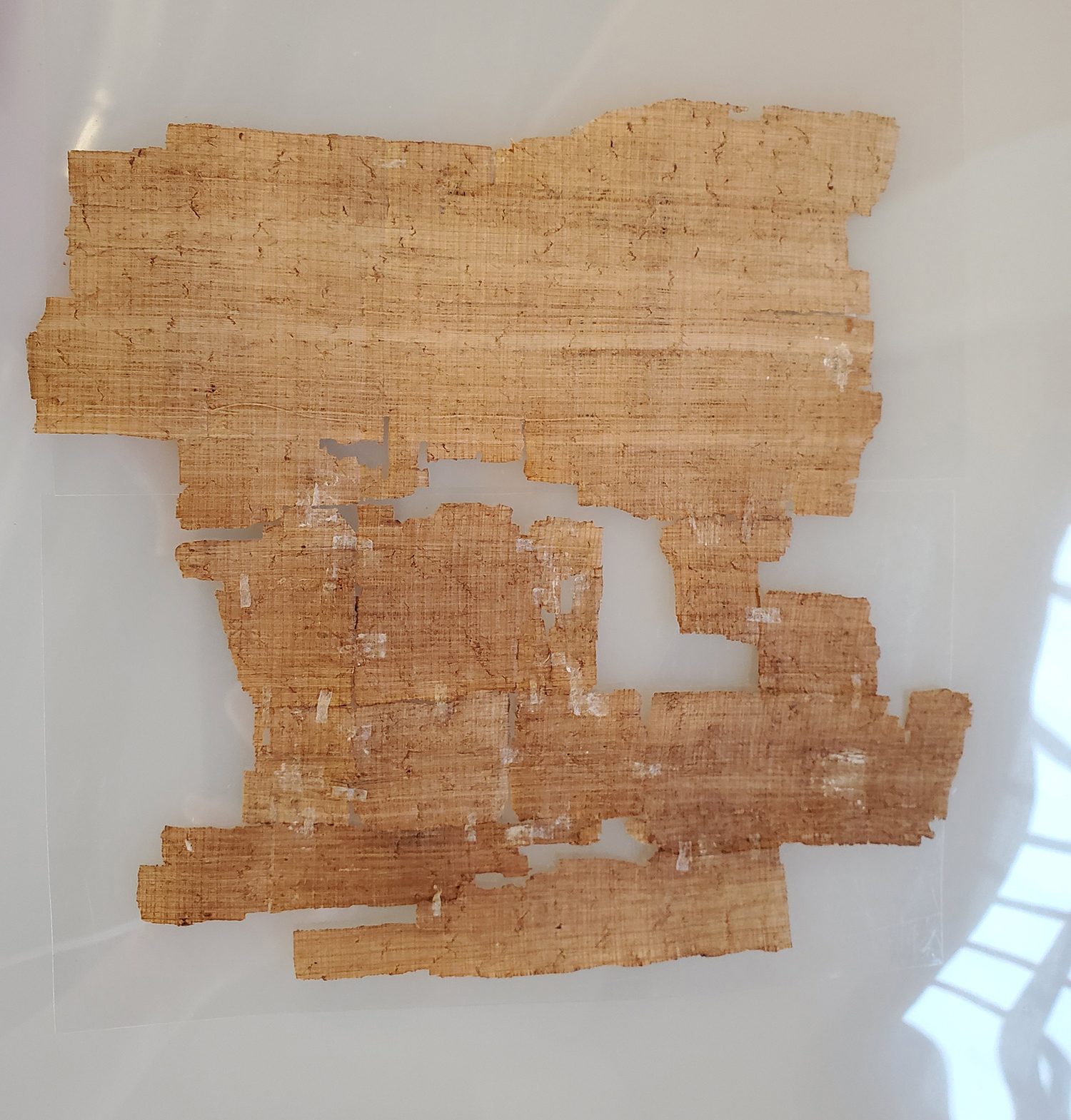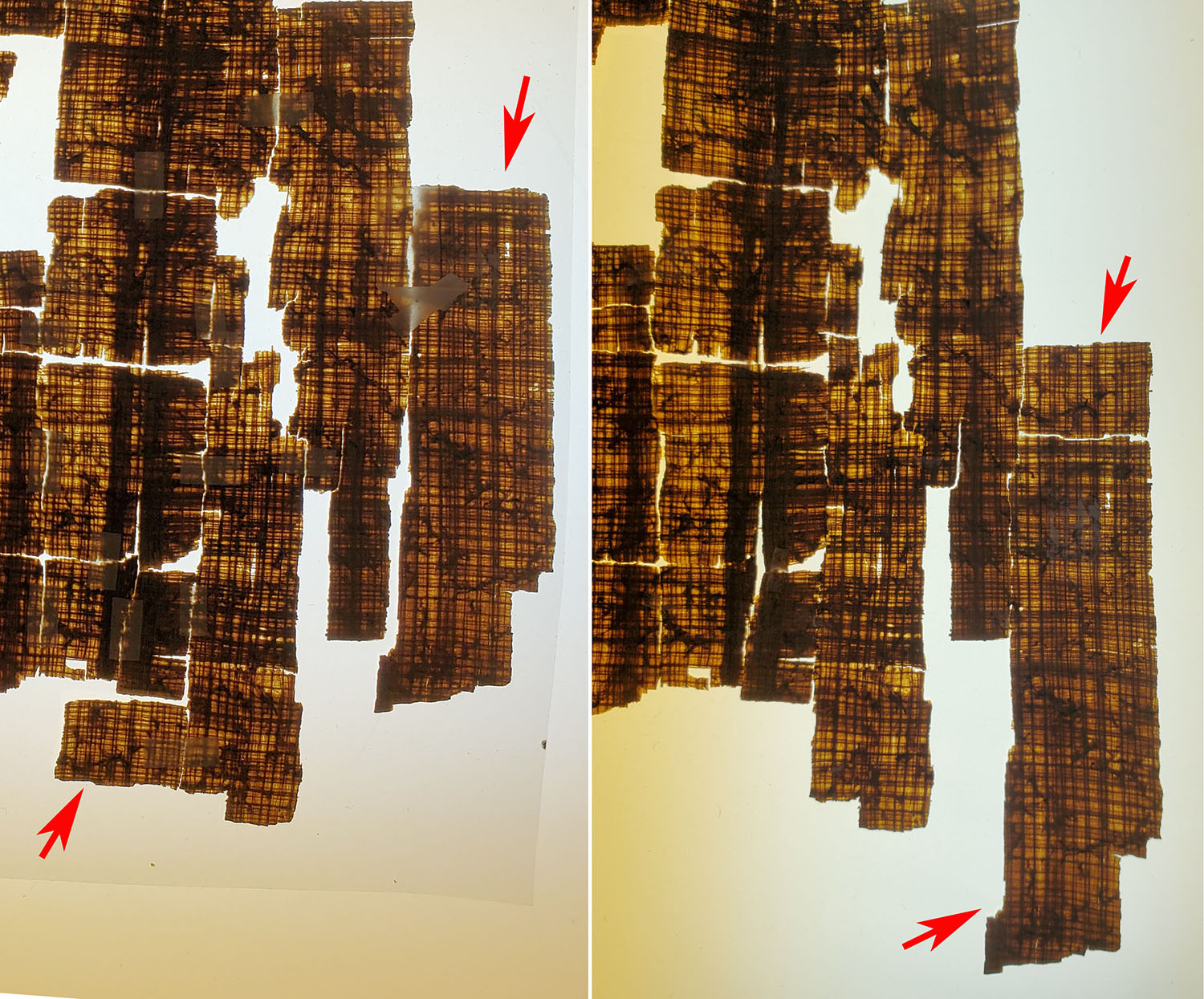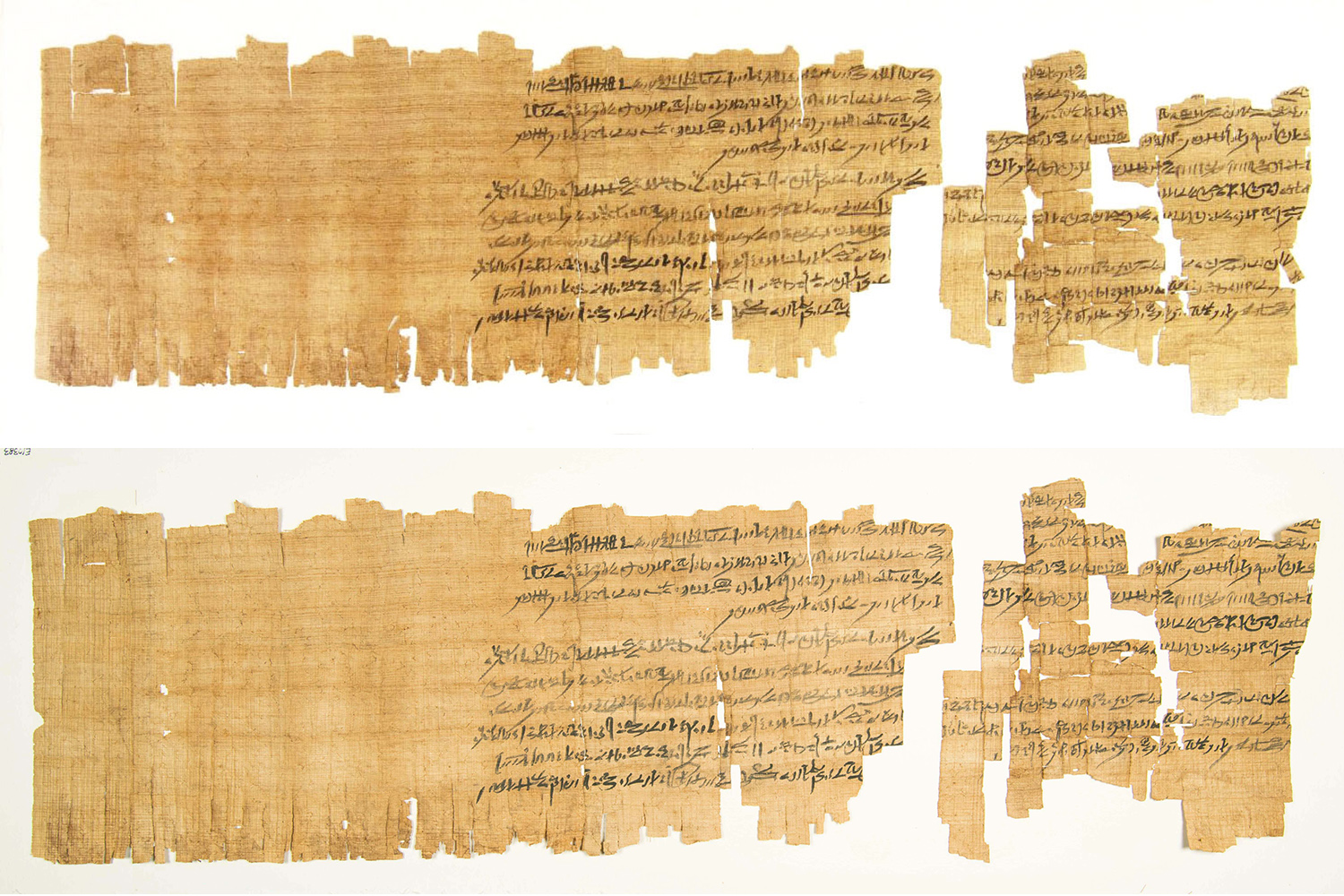- EraPharaonic, Coptic & Greco-Roman
- Project DirectorLynn Grant
- LocationPenn Museum
- AffiliationUniversity of Pennsylvania
- Project SponsorAntiquities Endowment Fund
- Project Dates2019-2020
The Penn Museum’s world-renowned Egyptian collection was founded in 1890 and is unusual in that the vast majority of the objects derive from more than 125 years of close cooperation with the government of Egypt and its ministries in sponsoring or conducting research excavations. The collection spans ancient Egypt’s history, from the Predynastic Period (circa 4000 BCE) through the Greco-Roman Period and into the Coptic Period (ending in the 7th century CE).
An important subset of the Egyptian collection is the Museum’s manuscript collection consisting of material relating to writing and literacy in ancient Egypt and Nubia. The collection features a wide range of personal, legal, administrative, literary, and religious texts written in seven languages. Manuscripts include Books of the Dead, a mythological tale concerning the deities Anat and Seth, a section of the Gospel of St. Matthew, and fragments containing text from Homer’s Iliad. Most are documents written on papyrus and the collection as a whole is often referred to as the “papyrus” collection, but it also includes documents on vellum and paper.
49-11-1, before treatment. Photo: Penn Museum.
Although the collection has been extensively used for teaching and research, there were serious anomalies in its cataloguing, making it less accessible than desired. This issue came to a head in 2016 when the entire Egyptian collection was inventoried prior to being moved off-site to make way for an ambitious renovation project.
The Museum was already in early planning phases for the renovation of the Ancient Egyptian and Nubian galleries and storage when the timeline for the inventory was accelerated by the construction of a new hospital adjacent to the Museum. Concerns for the safety of the collection necessitated we move the entire collection to a safer location. Although working on a compressed timeline, the Museum was able to use this major storage move to carry out a comprehensive inventory of the Egyptian collections. That work made clear the extent of the cataloging shortcomings in the papyrus collection. It also reiterated that the collection as a whole had a wide array of housing types, some of which did not offer sufficient protection to the fragile artifacts. Due to time limitations, it was not possible to address either of these issues before the move deadline, so the entire collection was moved ‘as is’ to a temporary, climate-controlled area within the Museum with the plan that the cataloguing and rehousing would be carried out prior to the reopening of the renovated Egyptian Collections storage rooms.
The cataloging issues were many: the records in the online database were often incomplete and did not match the fragments stored under that number; the same accession number had been used for more than one item; fragments clearly not from the same document or even in the same language had been grouped together, etc. Much of this was probably attributable to the less stringent approaches to cataloging at the time the manuscripts came into the collection in the late 19th and early 20th centuries, and the inability of some to read the texts. A scholar of papyrology, Dr Robert Kraft, had worked on organizing the collection, but his work had not been fully integrated into the Museum’s records.
Penn Museum manuscript storage before 2016 move; inset shows contents of a typical drawer. The wooden drawers did not slide smoothly and did not seal properly.
The condition and housing of the manuscripts had exacerbated the issues with collection. Inherently papyrus becomes brittle and fragile over time. Even careful handling can place stress on the fragments. Additionally, a variety of storage methods had been used. Most of the papyri surveyed were stored in Mylar enclosures sealed with double-sided tape or in folded tissue paper. Besides the risk of static and the papyrus dust caught in the tape, the Mylar enclosures often contained more than one piece and allowed the fragments to move freely. The tape enclosure has failed on a number of them, and the papyrus or vellum has begun to push through the tape. Other documents had been sandwiched between window glass, sealed with electrical tape. Some of tape’s adhesive had long dried out, allowing the encapsulated fragments to move. A variety of types of glass had been used, most apparently cut by hand with numerous sharp and irregular edges. Still other fragments were kept in envelopes made from tissue paper or waxed paper and the large amount of small fibers and dust in these enclosures indicated ongoing damage.
Project Conservator Jessica Byler removing papyrus from a Mylar enclosure using a MinION 2 Ionizing Blower to reduce static.
Clearly, this collection was in major need of attention but the scale of the project and the difficulty of the recataloging were daunting and it was difficult to determine where to start. Ultimately, With a grant from the Antiquities Endowment Fund, we were able to begin a conservation survey of the papyrus collection following a successful model that we had applied in other sub collections. We hired a project conservator, Jessica Byler, to complete the conservation survey of the collection and ensure that the objects were handled and documented with the greatest care. The results of the conservation survey would fulfill a number of goals: make it possible for subject specialists to correct the cataloging in accordance with current standards; identify the papyrus most in need of treatment; provide images for the Museum’s online database; and frame a plan for the eventual rehousing of the entire collection. This process began in the fall of 2019 and, despite the difficulties caused by the global pandemic, was completed by December 2020 with great improvements to the situation and accessibility of the collection.
Using a light box to determine correct alignments for detached fragments.
The temporary storage location for the papyrus collection was in a series of flat-file cabinets where each drawer contained multiple folders of papyrus fragments. Large items were stored on a rolling rack. While some attempt had been made to keep the collection in numeric order, the unwieldiness of the collection and the inherent cataloguing problems meant that this was not feasible. To complete the project, Ms. Byler had to examine each and every fragment individually. Our initial assessment had indicated that there were just under 700 accession records in the collection. The survey determined that there were actually over 1200 records, representing over 4000 actual fragments. Knowing the full scope of the collection will make planning for future phases of the process much more realistic.
During the survey, Ms. Byler examined and fully documented each fragment in the Egyptian manuscript collection. She created a spreadsheet with measurements, descriptions, condition issues, color and condition of any media, treatment and rehousing recommendations, and priority assessments. The manuscripts ranged in size from a few millimeters to almost 3 meters long. She determined whether there was adequate existing photography, and if not, took photographs. Where only one side of the double-sided document had been recorded, she added the reverse images. After completing the survey, the generated information and photographs were ingested into the Museum’s internal collections management system (CMS). From this CMS, data and images can be made available to the public via the Museum’s online database. The high-quality digital images resulting from the survey will also facilitate improved cataloguing of the collection by subject specialists without, in most cases, requiring further handling of the delicate objects.
Reverse of the same fragment as in Figure 2, after treatment, showing conservation-grade mends.
The spreadsheet also identified issues and discrepancies in the accession numbering of the collection. For example, there were 82 accession numbers which need to be split into 491 new records and 11 papyri which were not represented in the Museum’s CMS. As has been successfully carried out with other such surveys, the information compiled by Ms. Byler, especially the photographs and accompanying notes, will make it possible for the Collections Manager of the Egyptian collections to correct and untangle the current identifications.
Despite its past history, the manuscript collection was in relatively good condition, a testament to the durability of the material and the care taken by previous stewards of the collection. Of the manuscripts surveyed, the vast majority are incomplete, and almost half are fragmentary. In this context, incomplete referred to a manuscript with losses, whereas fragmentary referred to a manuscript in multiple pieces. Approximately a third of the fragmentary manuscripts have been visibly mended. These old repairs had not been documented and their materials were determined by observation. The methods and materials used varied in appropriateness and execution. Pressure-sensitive (Scotch-type) tape was often used, although some joins were made using mulberry tissue paper bridges. Many of the old mends had problems: adhesive failure, staining, and misalignments. Other fragments showed new breaks that had clearly happened since previous mending. This is an all-too-common occurrence where mending in one area places too much stress in another area, causing it to fracture in turn. The mending by the specialist reading the manuscripts to ‘temporarily’ record joins had not been followed up with a thorough campaign of stabilization, as would have been ideal.
The variety of repairs observed included joins using transparent pressure-sensitive tape, mulberry tissue paper bridges, or adhesives; backings and consolidation. Two-thirds of the fragments exhibit breaks, cracks, and insect damage. The insect damage was historic, with no ongoing pest issues. Misalignment, loose fibers, degraded tape, and detached parts were also common and indicated the need for conservation-grade mending. The most prevalent surface issue is staining, followed by sand and soil accretions, and natural ageing and darkening. Less common surface issues observed include folds, visible salt crystallization on the surface, and cockling, an undulating planar distortion.
Detail of 49-11-1, before (left) and after (right) treatment, using transmitted light, with arrows pointing to misplaced fragments.
Despite the compressed schedule, Ms. Byler was able to carry out treatments on a small number of papyri, those that would be exhibited in the first years of the exhibition. Many of the chosen papyri were sandwiched between pieces of Mylar. Static from Mylar can lift off friable ink or even split the two layers of the papyrus fibers and damage the papyrus. In order to remove the fragments safely from the Mylar, Ms. Byler used a MinION 2 Ionizing Blower to eliminate the static charge.
The Temple Robbery papyrus before (above) and after (below) current treatment.
Most of the pieces treated had old joins using transparent pressure-sensitive tape, archival Document Repair Tape, or adhesive-backed paper. Ms. Bylar removed old repairs, realigned misplaced fragments and fibers, and fixed them in place using new archival tissue paper bridges. A light box was used to aid in identifying joins and keeping fragments in alignment. The papyrus was mended using mulberry-fibered tissue paper bridges adhered with SCMC (Sodium carboxymethylcellulose). Kozo (mulberry) tissue was cast with SCMC using the method in Baker (2007) and applied using the method described in Lau-Lamb (2007). The tissue was not tinted. This remoistenable kozo tissue was cut into small bridges, lightly moistened with water to reactivate the adhesive, and applied to the papyrus using tweezers and a small silicone shaper. The bridges require only light pressure to adhere, dry almost instantly, remain reversible in water, and do not discolor. The bridges were around the size of a grain of rice and are clearly visible but blend in nicely with the papyrus due to their slight translucency.
As noted previously, most of the manuscripts were housed in Mylar enclosures. Other housing types included (from most common to least): folded tissue paper; glass; Mylar over a Volara foam tray; archival boxes; archival matting; waxed paper envelope; and polyethylene bags. Many of the Mylar enclosures had freely moving fragments inside, including 237 which had multiple accession numbers mounted together. These enclosures were not providing sufficient protection for the fragile papyrus.
As part of the survey, project conservator Jessica Byler undertook research into the latest thoughts on the best methods for housing papyri and manuscripts. This is an extremely important subject as the Penn Museum’s collection is heavily used for teaching and research. Identifying methods for reducing handling stress on the collection while allowing access for study was paramount.
Ms. Byler explored how other institutions surveyed, stored, and treated their papyrus collections. She visited the Papyrology Collection at University of Michigan and the Van Pelt Library at the University of Pennsylvania to discuss the treatment and storage of their papyrus collections. A lecture given by Melody Chen on her project to survey, photograph, treat, and rehouse New York University Libraries’ collection provided valuable insights and opportunities for further consultation. Other research trips had been planned, including attending the University of Michigan’s Papyrus Conservation Summer Seminar, but these were indefinitely postponed or canceled due to the global pandemic. Nevertheless, the treatment and rehousing options discussed and recommended during the consultations aided in the development of the protocols and methods of this project.
Originally, the hope had been to rehouse the collection as part of the collection survey project. By the end of January 2020, we realized there was more objects than we had expected, and by the middle of March 2020 we had to pause the project entirely during the Museum closure due to the global pandemic. We needed to remain flexible and prioritize what could be done in the time allotted.
Almost three-quarters of the documents were flagged to be rehoused during the survey. A small pilot project on rehousing 32 papyri enabled us to test the proposed methodology and extrapolate the time needed for application of this method to the whole collection. For this pilot project, priority was given to those documents that were slated for exhibition and those that had been flagged as unstable due to their housing during the survey.
Following the current best practices for housing a research collection of this type, the fragmentary manuscripts were transferred to folders with blotting paper. This system has been used to great effect in other research collections such as at the University of Michigan and the New York University, and came highly recommended by those conservators. The folders were created using sheets of 30pt cotton blotting paper adhered to one side of an archival folder, using the method described in Lau-Lamb (2005). The surface of the blotting paper has enough tooth to prevent movement of the fragments but holds them loosely enough that the other side of the papyrus is accessible by inverting the folder. This is less potentially damaging than using a Mylar enclosure, and more supportive than folded tissue paper where the fragments can freely move and crush each other. It will also allow for easier access and reorganization during the curatorial cataloging project which will further examine the problematic accession numbers . These folders will be stored flat and kept horizontal during handling. The Egyptian Curatorial staff had not been happy with the previous Mylar enclosures and were excited by this new system. Applying this system to the rest of the collection will be included in the preparations for returning the collections to their renovated storerooms.
As is the goal for most of the Museum’s conservation projects, we engaged public audiences in this project. Some of the documentation was completed in the Museum’s Artifact Lab , where conservators work in a gallery space and engage with visitors during twice daily open window times. These sessions allowed Museum visitors to see the ancient writings, hear about the manuscripts and the project, and ask questions. Most of the visitors were excited to see manuscripts which are not usually on display and quite interested in getting a behind-the-scenes glimpse at the project. When the Museum was closed to the public during the pandemic, we used social media to continue outreach. Ms. Byler wrote two blogposts for the conservation department’s In the Artifact Lab blog. The first blog post informed the public about the survey project, while the second blog post focused on the Temple Robbery Papyrus treatment. The treatment was also tweeted about by Penn’s Center for Analysis of Archaeological Materials for Puzzle Day.
Bibliography:
- Baker, C. (2007) “Sodium Carboxymethylcellulose (SCMC) Re-evaluated for Paper, Book, Papyrus, and Parchment Conservation,” The Book and Paper Group Annual, Vol. 26: 177-185.
- Lau-Lamb, L. (2005) “Advanced papyrological information system guidelines for conservation of papyrus,” University Library, University of Michigan.
- Lau-Lamb, L. (2007) “A New Material for the Conservation of Papyrus,” The Book and Paper Group Annual, Vol. 26: 187-188.

